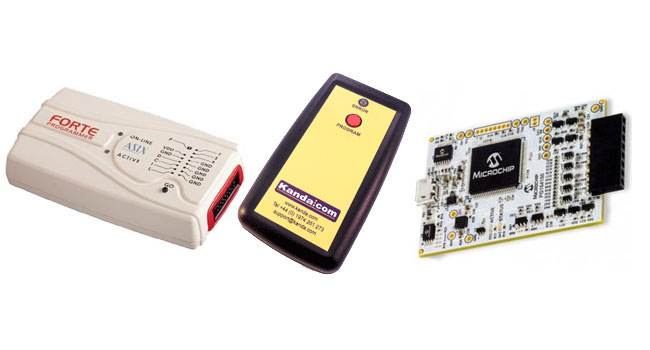Choosing the right PIC programmer depends on your project’s requirements, budget and your experience level. There are a number of factors to consider when making your decision.
Continue reading “Choosing a PIC Programmer” »Tag Archives: pic programmer
Choosing a Standalone Programmer
What is a standalone Programmer? This is a programmer that is loaded from a PC or laptop but once loaded, it is completely portable and does not require a PC to operate. So, how do you choose one?
Continue reading “Choosing a Standalone Programmer” »How to use Kanda standalone programmer for ATE
Kanda standalone handheld programmers, for AVR and PIC microcontrollers, are really simple to use. Once loaded from PC, you just select the correct slot and press the button. Now we have made it easy to add this simple operation to your ATE system.
Continue reading “How to use Kanda standalone programmer for ATE” »Intel Hex Files Explained
We often come across a problem where an understanding of Intel Hex file format will help in solving a programming issue or technical point. Intel Hex format is a standard layout for files produced by assemblers or C compilers when they compile your source code. It is used by device programmers to program the target microcontroller with your code.
Which Pic Programmer Do You Need?
Microchip PIC microcontrollers come in a wide variety of types from very old PIC16C family through to the latest PIC16F and PIC18F devices, with several other less common types as well. Apart from some very old chips, they are all In Circuit Serial Programmable, which means that they can be programmed in circuit using a PIC ICSP programmer.
Continue reading “Which Pic Programmer Do You Need?” »Handheld Programmer
Kanda have been supplying PIC, serial EEPROM, ST7, COP8 and AVR portable programmers for many years and are always extending the range. They vary from simple units in a keyfob case to larger hand held units with storage for one or more programs up to a portable programmer with LCD and keypad that will store 32 programs.
AVR and PIC Programmers in Windows 8.1
Windows 8.1 is here and more and more people will be forced to use it as they purchase new computers. I do not like it myself as I find it slow and clunky and even more of the system is hidden from you but it is here to stay. A pity, because Microsoft got it pretty damn right with Windows 7.
Firmware Field Updates
It amazes us how many people launch microcontroller based products without giving any thought to how they will update the product in the future. This may need to be done because there was a bug but more likely because of customers asking for new features or competitors producing better versions.
Custom ISP Connectors
To carry out In System Programming (ISP) of devices, such as AVR, ST7 and PIC microcontrollers or serial EEPROMs, you need an ISP connector on your PCB that matches the format on the programmer you intend to use, but this isn’t always that simple.
Firmware Updates in the Field
All microcontroller based applications include the microcontroller code called firmware but it is surprising how many people forget that they may need to update it when their products are scattered at customer locations. This may be because (heaven forbid) that they discover a bug in the system that needs to be corrected or, more commonly, that the product needs new features in response to customer feedback or competitor’s actions. So how do we simplify firmware updates?

